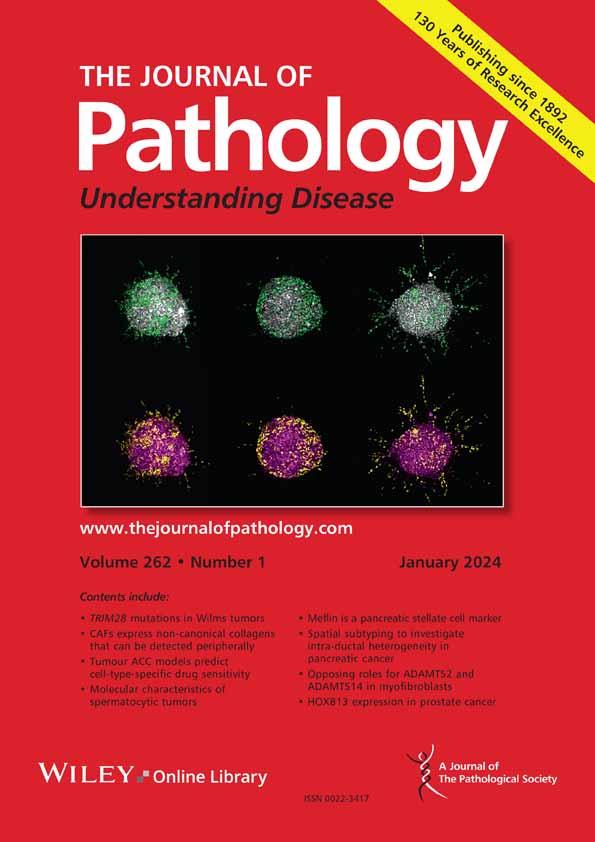Amal M EL-Naggar, Yuqin Li, Busra Turgu, Yuchen Ding, Longyijie Wei, Shary Yuting Chen, Genny Trigo-Gonzalez, Forouh Kalantari, Rodrigo Vallejos, Branden Lynch, Janine Senz, Amy Lum, J Maxwell Douglas, Clara Salamanca, Shelby Thornton, Yimei Qin, Kiran Parmar, Sandra E Spencer, Samuel Leung, Michelle M M Woo, Paul J Yong, Hai-Feng Zhang, Christopher S Hughes, Gian Luca Negri, Yemin Wang, Gregg B Morin, Poul H Sorensen, David G Huntsman
下载PDF
{"title":"半胱硫氨酸γ裂解酶介导的缺氧诱导因子1- α表达驱动透明细胞卵巢癌进展。","authors":"Amal M EL-Naggar, Yuqin Li, Busra Turgu, Yuchen Ding, Longyijie Wei, Shary Yuting Chen, Genny Trigo-Gonzalez, Forouh Kalantari, Rodrigo Vallejos, Branden Lynch, Janine Senz, Amy Lum, J Maxwell Douglas, Clara Salamanca, Shelby Thornton, Yimei Qin, Kiran Parmar, Sandra E Spencer, Samuel Leung, Michelle M M Woo, Paul J Yong, Hai-Feng Zhang, Christopher S Hughes, Gian Luca Negri, Yemin Wang, Gregg B Morin, Poul H Sorensen, David G Huntsman","doi":"10.1002/path.6433","DOIUrl":null,"url":null,"abstract":"<p>Clear cell ovarian cancer (CCOC) is the second most common ovarian cancer subtype, accounting for 5%–11% of ovarian cancers in North America. Late-stage CCOC is associated with a worse prognosis compared to other ovarian cancer histotypes, a challenge that has seen limited progress in recent decades. CCOC typically originates within the toxic microenvironment of endometriotic ovarian cysts and is characterized by its intrinsic chemoresistance, a strong hypoxic signature, and abundant expression of cystathionine gamma-lyase (CTH). CTH is a key enzyme in the transsulfuration pathway and serves as a marker of ciliated cells derived from the Müllerian tract. CTH plays a pivotal role in <i>de novo</i> cysteine synthesis, which is essential for glutathione (GSH) production and redox homeostasis. Using an array of molecular tools and cancer models, including <i>in vivo</i> studies, we demonstrated that CTH expression was induced under various stress conditions, such as exposure to endometriotic cyst content and hypoxia. This induction enables cell survival and creates a differentiation state manifested by CCOC that potentiates tumor progression and metastasis. In addition to regulating redox homeostasis, CTH enhances hypoxia inducible factor 1-alpha (HIF1α) expression, independently of hydrogen sulfide (H<sub>2</sub>S) production. Re-expression of HIF1α in <i>CTH</i> KO cells fully restored metastatic capacity in <i>in vivo</i> models. Co-expression of CTH and HIF1α proteins was also observed in human CCOC samples. Importantly, targeting CTH in CCOC significantly reduced its metastatic potential in <i>in vivo</i> models and enhanced sensitivity to chemotherapy. These findings underscore that CTH is both a defining feature of CCOC and a promising therapeutic target, not only for CCOC patients but also for those with other CTH-expressing cancers. © 2025 The Author(s). <i>The Journal of Pathology</i> published by John Wiley & Sons Ltd on behalf of The Pathological Society of Great Britain and Ireland.</p>","PeriodicalId":232,"journal":{"name":"The Journal of Pathology","volume":"266 3","pages":"352-367"},"PeriodicalIF":5.2000,"publicationDate":"2025-05-15","publicationTypes":"Journal Article","fieldsOfStudy":null,"isOpenAccess":false,"openAccessPdf":"https://onlinelibrary.wiley.com/doi/epdf/10.1002/path.6433","citationCount":"0","resultStr":"{\"title\":\"Cystathionine gamma-lyase-mediated hypoxia inducible factor 1-alpha expression drives clear cell ovarian cancer progression\",\"authors\":\"Amal M EL-Naggar, Yuqin Li, Busra Turgu, Yuchen Ding, Longyijie Wei, Shary Yuting Chen, Genny Trigo-Gonzalez, Forouh Kalantari, Rodrigo Vallejos, Branden Lynch, Janine Senz, Amy Lum, J Maxwell Douglas, Clara Salamanca, Shelby Thornton, Yimei Qin, Kiran Parmar, Sandra E Spencer, Samuel Leung, Michelle M M Woo, Paul J Yong, Hai-Feng Zhang, Christopher S Hughes, Gian Luca Negri, Yemin Wang, Gregg B Morin, Poul H Sorensen, David G Huntsman\",\"doi\":\"10.1002/path.6433\",\"DOIUrl\":null,\"url\":null,\"abstract\":\"<p>Clear cell ovarian cancer (CCOC) is the second most common ovarian cancer subtype, accounting for 5%–11% of ovarian cancers in North America. Late-stage CCOC is associated with a worse prognosis compared to other ovarian cancer histotypes, a challenge that has seen limited progress in recent decades. CCOC typically originates within the toxic microenvironment of endometriotic ovarian cysts and is characterized by its intrinsic chemoresistance, a strong hypoxic signature, and abundant expression of cystathionine gamma-lyase (CTH). CTH is a key enzyme in the transsulfuration pathway and serves as a marker of ciliated cells derived from the Müllerian tract. CTH plays a pivotal role in <i>de novo</i> cysteine synthesis, which is essential for glutathione (GSH) production and redox homeostasis. Using an array of molecular tools and cancer models, including <i>in vivo</i> studies, we demonstrated that CTH expression was induced under various stress conditions, such as exposure to endometriotic cyst content and hypoxia. This induction enables cell survival and creates a differentiation state manifested by CCOC that potentiates tumor progression and metastasis. In addition to regulating redox homeostasis, CTH enhances hypoxia inducible factor 1-alpha (HIF1α) expression, independently of hydrogen sulfide (H<sub>2</sub>S) production. Re-expression of HIF1α in <i>CTH</i> KO cells fully restored metastatic capacity in <i>in vivo</i> models. Co-expression of CTH and HIF1α proteins was also observed in human CCOC samples. Importantly, targeting CTH in CCOC significantly reduced its metastatic potential in <i>in vivo</i> models and enhanced sensitivity to chemotherapy. These findings underscore that CTH is both a defining feature of CCOC and a promising therapeutic target, not only for CCOC patients but also for those with other CTH-expressing cancers. © 2025 The Author(s). <i>The Journal of Pathology</i> published by John Wiley & Sons Ltd on behalf of The Pathological Society of Great Britain and Ireland.</p>\",\"PeriodicalId\":232,\"journal\":{\"name\":\"The Journal of Pathology\",\"volume\":\"266 3\",\"pages\":\"352-367\"},\"PeriodicalIF\":5.2000,\"publicationDate\":\"2025-05-15\",\"publicationTypes\":\"Journal Article\",\"fieldsOfStudy\":null,\"isOpenAccess\":false,\"openAccessPdf\":\"https://onlinelibrary.wiley.com/doi/epdf/10.1002/path.6433\",\"citationCount\":\"0\",\"resultStr\":null,\"platform\":\"Semanticscholar\",\"paperid\":null,\"PeriodicalName\":\"The Journal of Pathology\",\"FirstCategoryId\":\"3\",\"ListUrlMain\":\"https://pathsocjournals.onlinelibrary.wiley.com/doi/10.1002/path.6433\",\"RegionNum\":2,\"RegionCategory\":\"医学\",\"ArticlePicture\":[],\"TitleCN\":null,\"AbstractTextCN\":null,\"PMCID\":null,\"EPubDate\":\"\",\"PubModel\":\"\",\"JCR\":\"Q1\",\"JCRName\":\"ONCOLOGY\",\"Score\":null,\"Total\":0}","platform":"Semanticscholar","paperid":null,"PeriodicalName":"The Journal of Pathology","FirstCategoryId":"3","ListUrlMain":"https://pathsocjournals.onlinelibrary.wiley.com/doi/10.1002/path.6433","RegionNum":2,"RegionCategory":"医学","ArticlePicture":[],"TitleCN":null,"AbstractTextCN":null,"PMCID":null,"EPubDate":"","PubModel":"","JCR":"Q1","JCRName":"ONCOLOGY","Score":null,"Total":0}
引用次数: 0
引用
批量引用





 求助内容:
求助内容: 应助结果提醒方式:
应助结果提醒方式:


